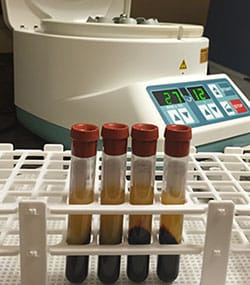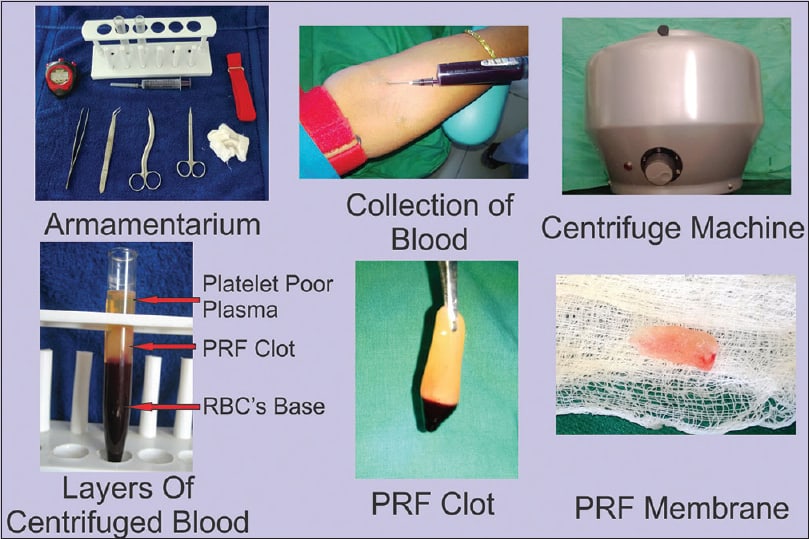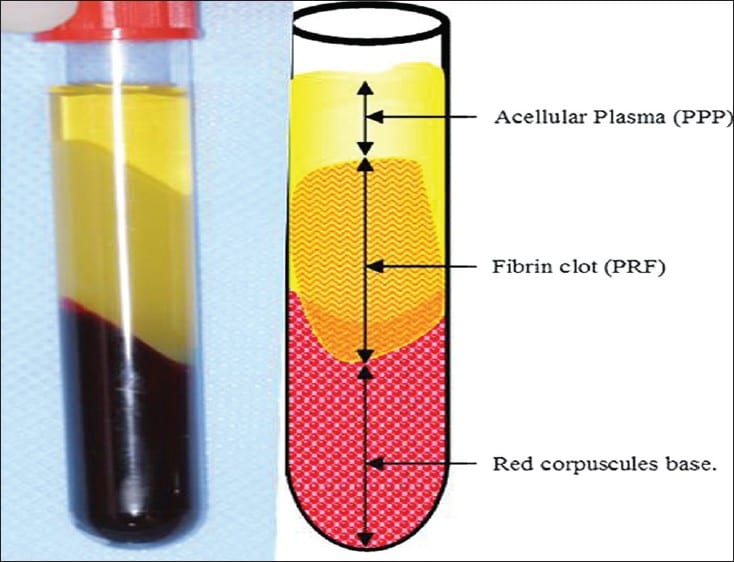When undergoing dental surgery, one revolutionary advancement often comes into play: PRF dental treatment. Platelet Rich Fibrin harnesses the healing powers of your own blood to enhance recovery, making it a critical ally for procedures such as dental implants and tissue regeneration. This guide explains how PRF works, its benefits, and how it’s applied in dentistry, providing a clear pathway to understanding this natural approach to post-surgical care.
Understanding Dental Platelet Rich Fibrin
- Platelet Rich Fibrin (PRF) is a substance derived from a patient’s own blood, rich in platelets and growth factors, which is used to accelerate healing in various dental surgical procedures such as tooth extractions and dental implants.
- PRF therapy employs growth factors and a fibrin matrix to enhance tissue regeneration, improve bone growth, and provide structural support to cells, contributing to faster healing and reduced complications in dental surgery.
- PRF is versatile in its application, with benefits including reduced healing times, decreased risk of postoperative infection, and enhancement of bone grafting procedures, solidifying its role as a key component in modern oral and maxillofacial surgery.
Understanding Platelet Rich Fibrin (PRF) in Dentistry
Picture a natural biomaterial, derived directly from your own body, capable of accelerating the healing process like never before. This is platelet rich fibrin (PRF), a yellow, thick jello-like substance obtained by spinning a patient’s blood in a centrifuge without anticoagulants. At its essence, PRF is rich in platelets and growth factors, elements that are quintessential for tissue regeneration. Its use in multiple dental surgical procedures, including tooth extractions and dental implants, signifies a new age of accelerated and efficient healing.
The effectiveness of PRF hinges on a simple blood draw, followed by careful centrifugation. This step requires immediate action to avoid premature clotting and to obtain a usable PRF clot, allowing patients to fully benefit from this innovative treatment during their dental procedure. As we peel back the layers of this fascinating material, we uncover its potential to not only improve the strength of dental implants but also to redefine the standards of patient care in dentistry.

The Science Behind PRF and Oral Healing
The power of platelet rich fibrin (PRF) lies in its ability to naturally boost the body’s healing processes. In the context of oral health, the mouth’s complexity demands not only a desire for proper healing, but a necessity for it to ensure long-term success. PRF treatment functions by releasing growth factors, which trigger collagen production and encourage the formation of new blood vessels—both vital for lasting tissue regeneration.
Clinical studies also reveal that PRF can significantly reduce soft tissue healing time following procedures like tooth extractions, when compared to the body’s natural healing rate. We will now explore the roles growth factors and the fibrin matrix play in this regenerative process.
Growth Factors Role
At the heart of PRF’s regenerative prowess are growth factors, the proteins that signal cells to kickstart the healing process. Think of them as the conductors of an orchestra, directing cellular activities essential for tissue repair. These growth factors, including bone morphogenic protein, PDGFs, TGF-β1, VEGF, EGF, and IGFs, orchestrate a symphony of responses that result in cell migration, proliferation, and collagen formation, all leading to the remodeling of the extracellular matrix and successful wound closure.
Furthermore, PRF’s influence extends to the very building blocks of tissue repair – the stem cells. By promoting the proliferation of mesenchymal stem cells (MSCs) and enhancing their differentiation, PRF not only accelerates bone growth but also stimulates bone regeneration, especially in areas with compromised bone volume. This action is particularly advantageous during jawbone grafting procedures, ensuring a robust foundation for dental implants.
The Fibrin Matrix
Envision a gel-like scaffold, one that provides a three-dimensional structure for cells to inhabit and thrive – that’s the fibrin matrix found in PRF. This matrix is a natural and complex network that encases white blood cells, fibrin, and stem cells to create an optimal environment for regenerative responses to injuries. It’s like laying down the perfect foundation for new growth, where tissue regeneration occurs seamlessly within the body’s own framework.
The fibrin matrix has several important functions in the successful integration of dental implants:
- Calming inflammation
- Curbing the activity of osteoclasts
- Protecting the delicate balance needed for integration
- Actively participating in wound healing and tissue repair
- Establishing an early blood supply at the wound site
- Fostering the arrival of other blood cells that contribute to bone formation and collagen production
The presence of the fibrin matrix is crucial for the overall success of dental implant procedures, as it helps to prevent dental implant failure.
Moreover, the insoluble protein that is fibrin serves as a natural barrier against infection, showcasing the human body’s remarkable ability to heal itself with a little help from its own red blood cells and blood.
PRF Application Methods in Dental Surgery
The flexibility of platelet rich fibrin (PRF) is showcased by the numerous methods of application in dental surgery. From enhancing the healing of dental implant sites to supporting oral surgery recovery, PRF’s applications are as diverse as the needs of patients undergoing these procedures. The process begins with a timely blood draw, immediately before the dental surgery, which is then centrifuged to harvest the potent layer of fibrin needed for treatment.
Once collected, PRF can be artfully injected into damaged or decaying dental tissues, acting as a catalyst in the natural healing process. In the case of tooth removal, the PRF plug is placed snugly into the extraction site, where it aids in both oral surgical and periodontal healing. This innovative approach is not only applicable to many dental surgical procedures but is also a cornerstone of advanced practices in oral and maxillofacial surgery.

The Advantages of Using PRF for Dental Implants
When it comes to the success of dental implants, stability is key. Herein lies one of the greatest advantages of using platelet rich fibrin (PRF): its role in promoting proper healing and jawbone regeneration. By facilitating bone healing, PRF not only contributes to the increased stability of dental implants but also fills the gap between the implant and the extraction site, effectively reducing the risk of implant failure.
Moreover, the use of PRF (Platelet-Rich Fibrin) in dental implant procedures has been shown to have several benefits, including:
Improved implant stability quotient, a critical measure of dental implant stability
Expedited healing process at surgical sites, leading to decreased pain and swelling
Psychological benefit by reducing postoperative discomfort
These advantages make PRF a valuable tool in dental implant surgery.

- Improved implant stability quotient, a critical measure of dental implant stability
- Expedited healing process at surgical sites, leading to decreased pain and swelling
- Psychological benefit by reducing postoperative discomfort
These advantages make PRF a valuable tool in dental implant surgery.
Case Studies: PRF in Action for Tooth Extractions and Bone Grafting
Real-world applications of platelet rich fibrin (PRF) demonstrate its transformative impact on dental procedures. Case studies reveal how its use in tooth extraction and bone grafting procedures has resulted in faster healing and reduced complications, a testament to PRF’s effectiveness.
From mitigating the risk of dry socket to improving graft stabilization and integration, PRF has proven to be a game-changer in dental care.
Tooth Extraction Site Management
In the delicate aftermath of tooth extractions, PRF takes center stage in dental extractions sites management, particularly at the surgical site. Its application to the socket at the time of extraction offers several benefits:
- Enhances healing
- Acts as a safeguard against infection
- Accelerates healing
- Reduces risk of complications, such as dry socket
These advantages have been a boon for patients and practitioners alike.
For those suffering from conditions that delay healing, such as diabetes or those on anticoagulant therapy, PRF serves as an advantageous scaffold that encourages neovascularization and tissue regeneration. Even in the painful scenario of an established dry socket, PRF treatment has been shown to significantly alleviate pain and inflammation, leading to notably improved wound healing within days of application.
Enhancing Bone Grafts
PRF’s role in jawbone regeneration extends into the realm of bone grafting, where it serves as a beacon of hope for patients with insufficient jawbone density for dental implants. Its osteoinductive properties and the continuous release of growth factors into the bone grafting material post-procedure aid in the healing process and successful integration of the graft.
In procedures such as alveolar ridge preservation, guided bone regeneration, and sinus floor elevation, PRF has showcased its ability to reduce bone resorption, enhance bone fill and density, and act as an effective sole filling material or in combination with bone substitutes. Whether mixed with bone graft material or layered within PRF, it creates a bioactive substance that improves manipulation during jawbone grafting procedures, thus enhancing the overall outcome.
Preparing for a PRF Dental Procedure
Undergoing a PRF dental procedure involves more than simply visiting the dentist. Patients are encouraged to provide a comprehensive medical history, including all medications and known allergies, to ensure a safe and personalized treatment plan. Adhering to pre-procedure advice, particularly regarding the avoidance of certain medications or supplements that may affect bleeding or clotting, is critical for minimizing risks.
Staying hydrated is another essential step in the preparation process. Patients are advised to drink plenty of water the day before treatment and to eat a normal meal to maintain stable blood sugar levels throughout the procedure. These simple yet significant measures can make a world of difference in the success and comfort of a PRF dental procedure.
Measuring the Impact: PRF’s Effect on Healing Time and Pain Reduction
The real testament to PRF’s effectiveness is its measurable impact on healing time and pain alleviation. By promoting optimum bone regeneration, PRF has reduced healing times, allowing patients to return to their daily lives with minimal interruption. The decrease in postoperative pain following tooth extractions is yet another feather in PRF’s cap, shortening overall healing time and improving patient comfort.
Moreover, the likelihood of post-procedure infections and complications is significantly decreased in patients treated with PRF. This not only speaks to its efficacy in wound healing but also to its potential in reducing the need for additional medications or interventions post-surgery.
Innovations in Oral and Maxillofacial Surgery with PRF
Oral and maxillofacial surgery is experiencing an influx of innovation, partially due to PRF therapy. Its antimicrobial properties and potential as a localized drug delivery system for antibiotics are areas of particular interest among researchers. Some benefits of PRF therapy in oral and maxillofacial surgery include:
- PRF loaded with antibiotics exhibits a marked increase in antibacterial activity
- PRF therapy offers a promising alternative to standard PRF
- PRF therapy decreases the reliance on systemic antibiotics
These advancements in PRF therapy are revolutionizing the field of oral and maxillofacial surgery.
PRF’s natural healing properties enable it to manage post-operative infections effectively. Its therapeutic benefits are particularly noteworthy in complex surgeries, such as the management of medication-related osteonecrosis of the jaw, where it promotes mucosal healing and prevents further complications. Such advancements underscore PRF’s role as a harbinger of a new age in surgical care.
PRF Therapy: A Natural Approach to Enhanced Healing
PRF therapy embodies a natural healing method, tapping into the body’s inherent regenerative abilities. By utilizing platelets and fibrin from the patient’s own blood, PRF therapy avoids synthetic additives or preservatives, thereby significantly reducing the risk of allergies or adverse reactions. This autologous nature ensures a tailored and safe application in a wide array of dental procedures.
Injections enriched with natural growth factors from the bloodstream promote tissue rejuvenation and expedite the healing process. Furthermore, the regenerative capacity of PRF is amplified by its fibrin content, which stimulates the activation of stem cells, encouraging the production of collagen and elastin crucial for healing. With PRF, patients enjoy the dual benefits of enhanced recovery and protection against infection, making it an exemplary model of natural, patient-focused care.
Summary
As we conclude this comprehensive guide on platelet rich fibrin (PRF) and its dental applications, it’s clear that this biomaterial represents a significant leap forward in dental medicine. From the intricate science behind its healing properties to the practical methods of application in dental surgery, PRF has established itself as an essential component in enhancing dental procedures. Its ability to reduce healing times, alleviate pain, and minimize postoperative complications has set a new standard for patient care.
PRF’s natural and autologous nature ensures that patients can undergo dental procedures with confidence, knowing they are benefiting from a treatment that is both effective and harmonious with their body’s biology. As dental professionals continue to innovate and apply PRF therapy in more complex surgeries, we can anticipate even greater breakthroughs in oral healthcare. May this guide inspire you to explore the possibilities of PRF in your dental journey, as we embrace a future where enhanced healing is not just a hope but a reality.
Frequently Asked Questions
What is Platelet Rich Fibrin (PRF), and how is it obtained?
Platelet Rich Fibrin (PRF) is a biologic material derived from a patient’s own blood. It is obtained by drawing a small amount of blood just before a dental procedure and spinning it in a centrifuge to separate out a layer rich in platelets, growth factors, and fibrin.
How does PRF enhance the healing process in dental surgery?
PRF enhances the healing process in dental surgery by releasing growth factors to promote tissue repair and regeneration, stimulating collagen production, forming new blood vessels, and providing a scaffold for proper healing.
Can PRF be used in all types of dental surgical procedures?
Yes, PRF can be used in a wide range of dental surgical procedures, including dental extractions, implant placements, and bone grafting, providing benefits in healing and tissue regeneration.
What are the benefits of using PRF in dental implant surgery?
Using PRF in dental implant surgery offers benefits such as promoting proper healing, increasing implant stability, facilitating jawbone regeneration, and reducing the risk of implant failure. Additionally, it accelerates healing at the surgical site and decreases postoperative pain and swelling.
Is PRF therapy safe and are there any risks of allergic reactions?
Yes, PRF therapy is generally safe and carries a low risk of allergic reactions due to its autologous nature, as it is made from the patient’s own blood. This greatly reduces the likelihood of adverse reactions.
 703-712-1053
703-712-1053 